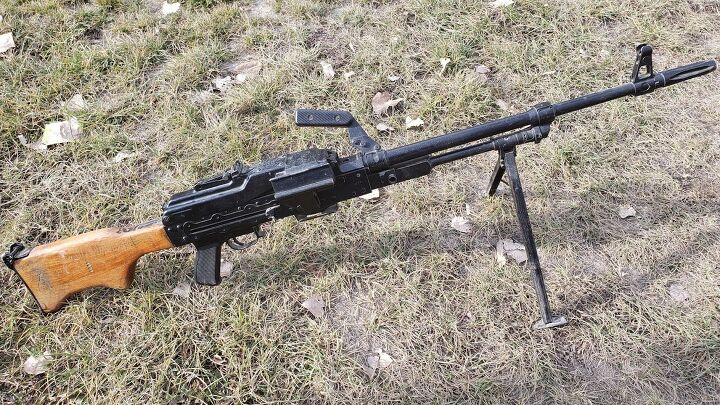"The Sower of Death" - the History of Yugoslavian M84 Machinegun

Recently I wrote a series of articles about the history of Kalashnikov GPMGs: PK and PKM. However, the history of this machine gun is not limited to the Soviet Union. Different versions of it are still produced in different countries: Bulgaria, Azerbaijan, Sudan, China, Ukraine, Romania, North Korea and Vietnam.
To me, the most interesting version of PKM is Yugoslavian/Serbian M84. Its history, operational use, and lore are truly unique. James Reeves already did a video about this topic, but I figured I could add a few more interesting details to this story.
How did PKM come to Yugoslavia?
If you do an internet search about M84, you might be surprised. There will be tons of photos of the Yugoslavian main battle tank M84. M84 is essentially a Soviet T-72 tank that was license-produced in Yugoslavia. The project for the production of this tank was called “Kapela”.
Why the GPMG has the same name? Well, that is not a coincidence. Within T-72, you have a lot of different parts. And since the Soviet Union was doing a full transfer of technology, they had to transfer documentation for every single trinket inside of the tank: lamps, gun racks, optics, helmets, mounted machine gun chambered for 7.62x54, radio, tiny foldable seats covered with fake leather, tracks, oil filters, a heavy machinegun called NSVT…
Maybe in that time, the Soviet Union was running a sale: “Buy one weapon system get two more for free”, but Yugoslavia basically received documentation for some of the best machine guns in the world as a package deal.
You may noticed that the M84 is using a non-standard PKM stock and pistol grip from the Zastava M70. That is because officially Yugoslavia received a transfer of technology (ToT) only for PKT, mounted machine gun, not for the actual PKM.
However, experienced Yugoslavian weapon design engineers easily reverse-engineered missing parts and created the M84 we all know. The copy of the mounted version of the machine gun, PKTM, is also produced by Zastava Arms under the designation M86.
The production of M84 started in 1984 and to this day it is one of the most popular products of the Zastava factory. Unlike M70 rifles, which before 2020 didn’t have chrome plating in the barrel and chamber, M84 was always manufactured with a chrome-lined cold hammer forged barrel.
The manufacturer guarantees that the barrel can withstand 18,000 without any decrease in bullet velocity. The quality of the barrel led to an interesting consequence - the accuracy of the M84 is between 1.5 and 2 MOA, so at times, the M84 with an optic was used as a bolt action sniper rifle. Soldiers loaded every other link and racked the charging handle to reload after every shot.
The many names of M84
M84 was used in numerous conflicts, the most famous being the wars in former Yugoslavia. During that time it got not just one nickname, but two.
The first one is “Ceca”. Some say it was the callsign of a particularly skilled Serbian machinegunner from one of the elite units, but most people agree that “Ceca” refers to the name of one of the most popular female singers in the region.
In the early 90s, she was so popular, that her promoters delivered her to a concert on a MI-8 helicopter, landing it in the middle of the stadium.
Apart from her songs, Ceca Ražnatović was famous for marrying one of the most prominent Serbian warlords, Željko Ražnatović, who was known as Arkan.
A few years after the wedding, her husband was gunned down at the Intercontinental Hotel in Belgrade.
Three years later, police searched Ceca’s house and found that the singer owned 11 different pistols without any permits. She said that some guns were presents from friends and some belonged to her dead husband and walked away after a short investigation. She still remains one of the most popular singers in the region.
The other nickname for M84 was less cheerful: “Sijač smrti“, which translates from Serbo-Croatian as “The Sower of Death”. It was a popular nickname for M84 in Bosnia.
Occasionally, those machine guns still end up in the Bosnian news - for example, in 2021, during COVID restrictions a group of friends in Sarajevo had a secret celebration at a restaurant, and one of them brought an M84 to shoot in the air to light up the party. Thankfully, no one got hurt.
My experience with M84
I maintained and repaired many M84s in Afghanistan and Somalia. After the inspection, I always wrote a detailed report.
In those reports, I typically recommended putting M84 on the most dangerous posts and towers. Those machine guns were new, typically in very good condition, so you could always rely on them even in the most dangerous situations.

Vladimir Onokoy is a small arms subject matter expert and firearms instructor. Over the years he worked in 20 different countries as a security contractor, armorer, firearms industry sales representative, product manager, and consultant. His articles were published in the Recoil magazine, Small Arms Review, Small Arms Defence Journal, and Silah Report. He also contributed chapters to books from the "Vickers Guide: Kalashnikov" series. Email: machaksilver at gmail dot com. Facebook: https://www.facebook.com/Vladimir-Onokoy-articles-and-videos-about-guns-and-other-unpopular-stuff-107273143980300/ Instagram: https://www.instagram.com/vladonokoy/ YouTube: https://www.youtube.com/user/machaksilver
More by Vladimir Onokoy













![[NRAAM 2024] A Magnetic Red Dot Mount from High End Defense](https://cdn-fastly.thefirearmblog.com/media/2024/06/04/0643119/nraam-2024-a-magnetic-red-dot-mount-from-high-end-defense.jpg?size=350x220)













Comments
Join the conversation